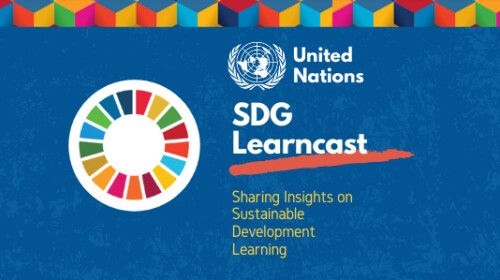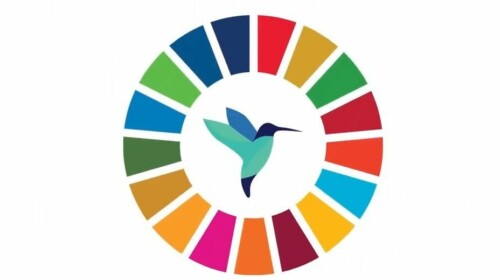Blockchain technology has been used in humanitarian settings by the World Food Programme to deliver cash directly to beneficiaries securely and quickly, without the need to go through a local bank. The potential of blockchain in protecting the environment has also been tested to eliminate illegal fishing in the tuna industry. Blockchain technology is also being considered to provide a transparent, trustworthy way to show how nations are taking action to reduce their impact on the climate.
In this SDG Learncast episode, we spoke with Ms. Thy-Diep “Yip” Ta, Co-founder of UNIT Ventures and DLT Talents, to unpack the blockchain technology for our podcast listeners and explain how the blockchain technology can also help vulnerable groups get access to financial resources, support people working in the care economy, and creating more incentives for collaboration, transparency, and good behavior through the blockchain technology. You may contact her at https://www.yipworx.com/.
Want to learn more about sustainable development and learning? Subscribe to SDG Learncast on podcast apps.
[Transcript of the podcast]
Paulyn Duman: Welcome to the SDG Learncast with me, Paulyn Duman. In every episode, I bring you insightful conversations around the subject of sustainable development and learning, helping us all to achieve a sustainable future.
In this episode, we will be speaking about blockchain technology or blockchain as a tool for a more equal society. How can we really harness cryptocurrency to build a sustainable economy? In today’s episode, we have our speaker Ms. Thy-Diep Ta or Yip. She is the co-founder of Unit Ventures and DLT Talents. Welcome to the SDG Learncast, Yip!
Thy Diep Ta (Yip): Hello everyone. Thank you very much Paulyn for welcoming me to your podcast today.
Paulyn Duman: Can you tell us a bit more about yourself and about your journey to blockchain technology?
Thy Diep Ta (Yip): Sure. So I’m Vietnamese, born to Vietnamese refugees that left the home country after the Vietnam war and ended in Germany. So I’m Vietnamese by background, but was born and raised in Germany, which is a very beautiful place to be immersed immediately as a refugee family, into German society. I grew up in a very small village with a few thousand inhabitants only.
I was fortunate enough to go to a high school and then go to university, finish a master’s degree, a few MBA degrees and worked in some of the leading organizations like economic organizations in the world.
I studied business because when I was in high school, Muhammad Yunus won a Peace Nobel prize. And it was about bringing banking to the unbanked. The concept of social enterprises or the concept of micro-financing did work as a tool and a means of empowerment, but it did not scale to the masses yet, and then worked in a few different ventures and so on.
And I went to World Economic Forum, and I was always having this question in the back of my mind. I was like, how can we actually combine technology for good? How can we actually bring things to those in need?
And I realized there’s this new technology like called blockchain and there’s this world called cryptocurrencies. And somehow they believe that this can bring a major change to our systems at the moment.
Paulyn Duman: If you can explain in simplest way for beginners and non-tech listeners what is blockchain technology?
Thy Diep Ta (Yip): You could think about blockchain technology when blockchain is like a chain of blocks and each block, there’s a certain piece of information. A certain piece of information is just like very similar to when you look at an Excel table, you have records of transactions of who owns what.
So when you think of the blockchain, there was always like a first transaction that where something was created, let’s say a hundred Bitcoins were created during the Bitcoin case. Then the first Bitcoin was created and belongs to someone and that person has to write, or this individual has the right to go to transfer, whatever they have to another account.
So this transaction needs to be recorded somewhere, right? And it’s recorded in a ledger, an electronic ledger, you could imagine just like a Google sheet, but it’s not rows, but it’s blocks. And in the blockchain world, like a couple of transactions are put together in a block and then they are encrypted and the next block is mined.
So why are they in different blocks? The difference is when you have a system and this is what made it so revolutionary, Now you have an open file, an XML file, and everyone has the right to add something to it.
And in the blockchain world, people use mathematical computation and models on how to make sure that, you only add up something when you are sure that the information you add in is correct. That’s the first thing. Like you have an incentive to only at right information and you have that because everyone else can validate if the information that you put in is not correct.
And they can notify the system that this information is wrong. The moment when somebody notifies that the system is not correct. And basically when it comes out that the information that you put in is wrong, you will get slashed or punished and the way to make that incentive of punishment so strong that you will not be incentivized to put in wrong data is what people call the consensus mechanism.
Paulyn Duman: So can I just summarize what you just said. So what you mean is the blockchain technology is where everyone, meaning it doesn’t matter if you’re rich or poor can have access to this technology. And then through this technology, they can make transactions similar to in the financial world, like purchases and buying things for their, let’s say for their household.
But the difference is that there’s no cheating in this system because it’s not a person or institution that corrects it or checks it but it’s a mathematical computation which checks it. Which means that if someone tries to cheat and they put something there that is not correct, then the system will punish and actually make it transparent that what you put is actually incorrect.
Am I right in making this summary?
Thy Diep Ta (Yip): Yeah, totally. So that’s basically it in simpler forms. Every blockchain has their different mechanisms to ensure the integrity of the blockchain. But when you mentioned that everyone, rich or poor can enter, this is what we call a permissionless of system. Don’t have to ask for permission to be participant in that ecosystem in different way.
Trustless system means basically you don’t need to trust the goodness of the players, the different actors in that ecosystem. You don’t have to trust that they’re good because you have incentive mechanisms in place that incentivize people for good behavior. You basically get rewarded when you put in a new transaction to the blockchain, for example, in the Bitcoin world, you basically mine a new block and there’s a block reward.
Paulyn Duman: So blockchain technology is a bigger concept, but there are different applications that can be used or how the technology is applied to help society. And I think what is very interesting to listeners is maybe you can give some examples of blockchain applications that actually help society or achieve public goods as you have also mentioned.
Thy Diep Ta (Yip): So we have like many big blockchains that market is currently two trillions for those blockchains will have like coins that are listed on the market. So it’s about probably 2% of the current equities market. So still a lot of room for growth, very small kind of market.
So when you think about blockchain, typically, they are linked to cryptocurrencies and cryptocurrencies is programmable money. Like it’s built with a token that can be sent from A to B in this ledger called blockchain technology.
And it can contain any information and work as with what if function, for example, if Paulyn does A, then B happens, and you can program this little units of currencies in different ways, according to different behaviors and preferences. So what it does is actually now more in more simple terms, what it does is it brings more precision into the market.
Then with all this big data and so on, you started to do customer segmentation, n=1. You can break down the segmentation of customer to one single person, and even you can break it down even further to their own preferences or their behaviors.
This is how precise we can be in marketing, personalized the same in medicine, we had like cancer treatment chemotherapy until a few years back. It was very like, targeting. You just that use a lot of medicine and target the same thing. And now we have precision medicine where we can individualize treatments.
In the blockchain world, and that you mentioned already earlier, everyone can basically participate. You need a wallet. The banker in New York can participate, but also the mother in Bangladesh, everyone, as long as they have internet, so that still a requirement can basically plug into that internet of value.
Paulyn Duman: This is a really complex topic and for me, the technology is so complex. And so from what I understand, so the blockchain technology is out there, so it’s a bigger concept. And one of the applications that you mentioned is cryptocurrency, and there are a lot of examples of cryptocurrency. So that is an application of that, of the blockchain technology.
How is that technology, the cryptocurrency, how can it help communities in Bangladesh? Let’s say.
Thy Diep Ta (Yip): It’s about accessibility to the market, right? So what we actually still need to do in the entire industry is to solve something called the last mile delivery or the off-ramping, what we call in crypto industry, the off-ramping of assets. So let’s say the mother in Bangladesh, she can participate in the global project somewhere anyway, which company, and she can receive a payment in cryptocurrencies, let’s say in Bitcoin cash or whatever, because very little transaction costs and you can send it across the border. It’s there instantaneously, almost instantaneously.
So she has this now these digital assets in her wallet, and now she wants to pay her rent, send her child to school. So what can she do? She needs to cash it out. If she needs to bring it back to fiat, as we call it or money traditional, local currency. And then she needs someone who basically cashes it out for her.
So there are people who basically cash digital assets into real cash, just in the way they would cash Euros or US dollars into Vietnamese Dong. So this is not different to today. When I sent money back to Vietnam to support my family, people still need to change the Euro into some Vietnamese Dong. And this is the same with digital assets.
So that for the case that she wants to participate in global currency, a global market, but that enables her to use the assets. She can get alone on whatever she earns and she doesn’t have to pay horrendous sums, like she would, because she doesn’t have access to the banks and she doesn’t have access to unit credit scoring, traditional credit scoring, right?
Paulyn Duman: what governance structure do you know? Because of course for instance, for my grandparents are from my parents, they would only apply for banks that were allowed by the government to be registered.
On the one hand, there is the education for the users, but there’s also, there is also the governance structure. And can you maybe give us a picture of how society is building institutions or a governance structure so that people can go to, government approved institutions like the banks, right?
Thy Diep Ta (Yip): Web three is here to stay, might not go away. So governments have pressured to really start to try to understand what is the upside, what is the downside? How can they benefit and how do they have to protect those unprotected? So a lot of the first step, what you’re seeing in the markets is governments are scaling up right now, trying to learn about digital currencies while shaping the regulatory framework.
So what they typically do is require some kind of license of operations, so that if you want to be a player holding any kinds of assets as a financial service product in that country, then you basically have to have certain compliance to be able to operate in these markets. So there’s like a lot of KYC requirements.
For example now, if you want to buy cryptocurrencies, you have to go to an exchange. If you go to an online exchange, you basically have to do Know Your Customer (KYC) requirements. So you basically have to submit a lot of documentation that you are a real person that is allowed to buy this certain asset in order to do something within your jurisdiction.
So now the exchanges, KYC know your customer. So basically banks or exchanges have to ask you to validate your personal information so that they are allowed to offer you their services. All of this is coming at the moment, so you can basically see that more and more. They ask for this. You cannot, in some countries, even people talk about not allowing you to just open an unhosted wallet.
So governments and players in the market, they all still trying to find the right balance. And some jurisdictions are a bit more progressive and have already decided what will be their strategy. So they are like, jurisdictions like Singapore, Dubai, maybe even Bahamas. If you were to say so, they have already made their bets on how they want to play the game.
And then some jurisdictions like the European Union and so on. They’re a bit more observing still. So they haven’t given clear guidance of what will be allowed and what will not be allowed in terms of operations in the markets. So regulations are now in proposal state and then will be voted for and against.
Paulyn Duman: So if you have some examples of where like a specific example, let’s say a community where you know that cryptocurrencies or maybe other applications of blockchain technology are being used to build a more sustainable society.
Thy Diep Ta (Yip): There’re a lot of projects at the moment that are happening building up, solutions for climate change issues. For example, there has not been any one that I think has shown their viability yet, but there are a lot of solutions are popping up, as in, how can we trade carbon credits, for example, voluntary carbon credits market for climate change.
There’s a lot of things and I’m building one of these solutions at the moment for mental health. So we’re seeing one of the new business model innovations in blockchain is called X to earn, you maybe know it from Philippines. Last year, there was this really big hype about something called Play to Earn. It was a computer game, like a game called Axie Infinity. And with that game as a player, you can earn. So it’s like play to earn, and then it became like a big hit in the Southeast Asia markets during Corona pandemic. Established a model called Play to Earn, but then this was the third of its kind that really survived.
And now we have a lot of new models, similar to theirs called X to earn an X can be replaced with anything .You can think of, Learn to Earn, Run to Earn, Move to Earn
Paulyn Duman: Create Arts to Earn…
Totally. So what you can now see is there’s an intact creator economy with the arts economy, built on the blockchain, where people starting to, create arts and sell digital arts globally across borders and receive their income and cryptocurrencies and NFTs.
And on the other hand, like more like the gaming model, like kind of projects that try to bridge the real world with the digital assets where in our case, for example, it’s mental health. So it’s SDG three. How can you incentivize people to practice meditation? Knowing that meditation over time might lead to some desirable health benefits, but knowing that also you need to practice the same behavior over time so that it becomes sticky.
Paulyn Duman: And I think that will really benefit the care economy in that sense. But in what example will they be benefiting from this?
Thy Diep Ta (Yip): Micro-transactions ,micro-services will be worth more. Basically if you spend six hours a day taking care of your parents and you only have two hours a day left to do something in the market, you cannot really make a living for two hours a day. There’s no models, but now we have micro jobs available in the global market.
And means to reward these micro-services. You know, We see a lot of this actually in the gig market, right? Executive virtual assistants, a lot from the Philippines that actually full day, they work taking care of the family and the children. And four hours a day or three hours a day for a few days a week, they participate as virtual assistants because they’re highly qualified for other companies in the world.And now we can just send payments there easily then without high transaction costs.
So that’s one, one other way to think about it. So making the unpaid payable. Because we increase cost efficiency off transactions and of means so we can enable everyone to participate in that world.
And the third one is really everyone owns a stake. We’re going to see that world coming where things that have been thought to not be able to get a pricing, a value, will now be able to receive that value.
And that really links to a lot of public goods problems like climate change. How do we actually give value to projects that protect the soil, for example, or that give value to the soil by reworking the soil. Reforestation, for example, but how can we have these projects get access to financial capital to build the project. And also how can this value be redistributed to all those who contributed to building that project, to making sure that this project took place as entering a new era of like collaboration, borderless collaboration.
Paulyn Duman: And for me, the three lessons that I’ve gotten from what you just said is that the first one is that the blockchain technology is really trying to shift the world economy from a world of competition to collaboration where collaboration is, of course incentivized more, which means that the winner is always the most collaborative. Second, it is trying to make the invisible visible, the unpaid paid. And I think I really like your example on the care economy, where people who care the elderly and for children can also then participate in the economy and get paid because of course in the system that we have now, this is actually the issue.
And the third thing that I really like about what you said is that it’s also trying to make everyone a stakeholder, which means that it is not only exclusive for people who have the means to have a stake. So usually in the boardroom of shareholders and who will get the usual dividends, but then here, everyone who is part of the system will be able to put the stake in anything that they really believe in, be that communities, be that projects that help other people and not just in their own countries or in their own cities, but also different parts of the world.
And for my last question Yip, we have a lot of young people listening to this podcast. What would be your message to them who are interested in understanding more in the blockchain, understanding more the blockchain technology and also where can they find more information and resources. And as you mentioned, like some courses that is available or that are available for them?
Thy Diep Ta (Yip): Yes, totally. So my main message is please, everyone, come in and contribute to shaping the technology of tomorrow already today. Blockchain technology is like the internet was in 95 nowadays 97, so it will be prevailing in your life in every day. And what you can do is now actually contribute and shaping its future development.
It’s like a baby and it needs a lot of care and nurturing from good parents, from parents with good intentions and good skills to come and help the baby grow up with a source of inspiration. So it’s very important that you all get skilled up. So how do we get skilled up. It’s you can go for the six weeks UNIT Master’s program (free-of-charge).
We have every two months, we have a new batch. We got to train 100,000 this year. So you will be the pioneers of the future economy. Second, you can find like a lot of good online education materials on Coursera, for example, like a lot of free material. Watch YouTube videos , listen to podcasts like ours for example because the economy is developing so rapidly that it’s to listen to like key influencers speak about the technology because they always give you the latest insights when you read something, it might already be obsolete the next day.
Paulyn Duman: Thank you so much Yip for your time.
Thy Diep Ta (Yip): Thank you so much Paulyn. And I hope somebody like, if anyone has any questions, reach out to me anytime. I’m happy to clarify.
Paulyn Duman: And that was Ms. Thy-Diep “Yip” Ta, co-founder of Unit Ventures and DLT Talents unpacking the Blockchain technology for us and how it can potentially help get people out of poverty, incentivize healthy behaviours, and make society hopefully, more collaborative in the future.
You can find more of the SDG Learncast on the UN SDG:Learn website. For now, I’m Paulyn Duman. Thanks for listening.
Paulyn Duman is the Knowledge Management, Communications, and Reporting Officer at the UNSSC Knowledge Centre for Sustainable Development and is a coordinator for the Joint Secretariat of UN SDG:Learn, together with UNITAR.
The opinions expressed in the SDG Learncast podcasts are solely those of the authors. They do not reflect the opinions or views of UN SDG:Learn, its Joint Secretariat, and partners.







